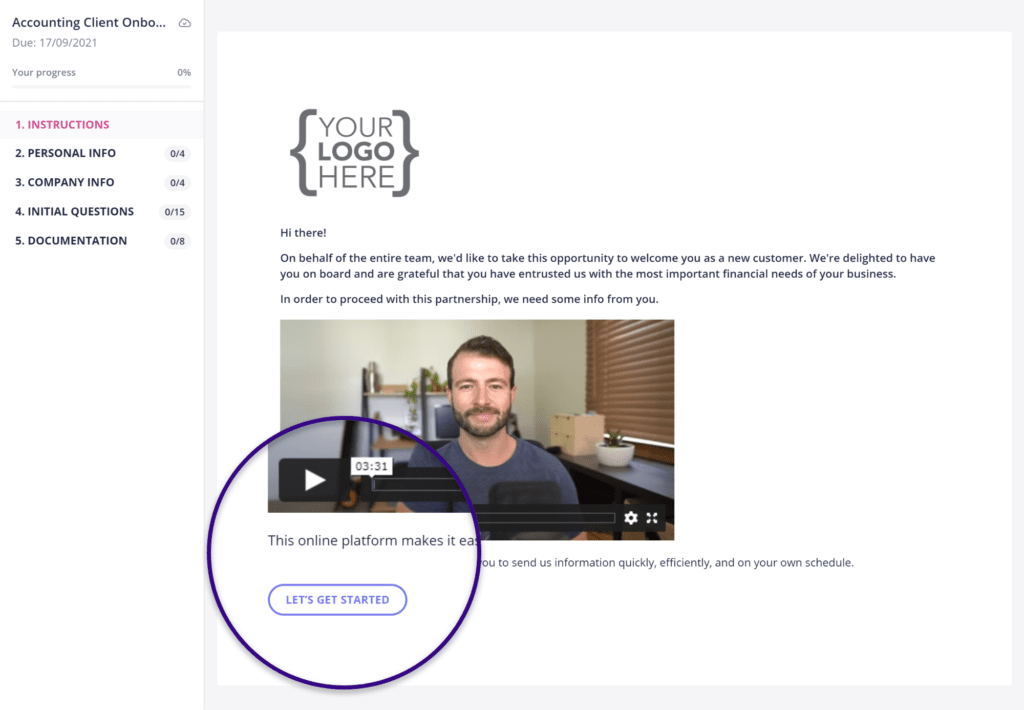Congratulations, you’ve landed a new client!
Before you jump into the work, there’s an important process you need to get right: Client onboarding. After all, first impressions matter. You want to hit the ground running, and that means a slick, hassle-free onboarding process.
In this article, we’ll explain everything you need to know about building an effective client onboarding process, covering:
- The benefits of getting client onboarding right
- What makes for a successful client onboarding process
- Some tips and tools to help make it smoother
But before we get started, let’s define what we’re talking about…
What is a client onboarding process?

Client onboarding is the practice of welcoming a new client into your business. It includes everything that needs to happen once your lead-generation process is over, before you start working with your new client.
The simplest way is to use client onboarding software. It’s a highly practical process, where you get all the information you need from the client to be able to serve them effectively.
From the client’s side, it offers a first glimpse into how you operate as a business. It sets the tone for all future interactions. So it’s pretty important to get it right.
Depending on the type of service you offer, your onboarding process may include:
- Accepting your proposal
- Signing contracts or T&Cs
- Paying a deposit
- Gathering key client information
Related: How Clarity Bookkeeping sped up their client onboarding and client queries
Is this the same as the customer onboarding process?
Not exactly.
The words ‘customer’ and ‘client’ are often interchangeable.

But in this instance, they mean something slightly different:
- Client onboarding: Outlining key elements of how you will work with a client, ensuring you have everything you need to start working with them.
- Customer onboarding: Setting new users up for tech products, particularly SaaS products. In this respect, ‘customer’ is synonymous with ‘user’.
Who needs a client onboarding process?

An effective onboarding process is important in any service-based industry. But it’s particularly crucial in areas such as:
- Finance and mortgage
- Accounting and bookkeeping
- Legal
- Agency client onboarding
- Insurance
- Real estate
Why?
Because businesses in these industries onboard a lot of clients. And in all cases, serving those clients requires them to gather a lot of information and data. Document collection is a big challenge, too.
You could also create an effective client onboarding email template to streamline business processes and ensure a positive client experience. In addition, service-based companies also need to outline and agree upon expectations, timelines, and outcomes from the start.
No matter what services you offer, starting on the right foot is important.
A successful onboarding process sets the tone for a stronger client relationship and helps you avoid common onboarding mistakes.
What are the benefits of having a client onboarding process?
So what makes a client onboarding form so important? What benefits can you hope to enjoy if you deliver a great client onboarding experience?
In this section, we’ll highlight some key examples.
1. Align expectations from the start

New client onboarding is a great place to set out what each party can expect from the other. Doing this at the start of your cooperation can help you avoid all manner of problems down the line.
This is a chance to agree upon key factors such as:
- Outcomes and deliverables
- Timelines and deadlines
- Payment
- Communication
It’s also an opportunity to gather all the information you need from your client. This could include everything from basic contact details to specific project-related information or documents.
It may be tempting to dive straight into the actual work. But setting expectations at the start will make things clearer in the long run. This will enable you to create a stronger working relationship based on mutual trust.
2. Understand your client’s needs
Whether you’re a content marketing agency or a financial advisor, you need to know what new clients want to achieve before you can help them get there. These details should be discussed during onboarding, before the actual work starts.
The key here is to get as much detail as you can. This will avoid issues or questions down the line, saving you and your clients time.
You can use a well-written client intake form to achieve this. Naturally, the specifics of the form will depend on your business, but the aim is to find out the answer to broad questions such as:
- What are your client’s aims?
- What issues do they want to solve or avoid?
- Where do they want to be in the future, compared to where they are now?
- What materials, resources, or documents can they provide to aid the process?
- What would success look like, and how would it be measured?
3. Boost client retention and satisfaction
In the service industry, it can be tempting to see winning new clients as the holy grail. But retaining existing clients is just as — if not more — important than acquiring new ones.
If you consider that the cost of acquiring new clients is five times higher than the cost of keeping existing ones, you can see why.
Once you’ve won a new client, a well-thought-out onboarding process will help ensure they stick around. They’ll see from the start that they’re working with a highly organized, thoughtful, and efficient business.
Not only do happy clients stick around, but they also tend to spread the word. By providing an outstanding onboarding experience, your clients will be more likely to give you great reviews and testimonials, or tell their peers about your services.
4. Comply with regulation

Depending on the industry you operate in, your client onboarding process may contain elements of legal compliance. You may need your client to sign a contract, or provide certain legal documents for you to get started.
New client onboarding allows you to bake legal requirements into your processes. This in turn reduces the risk of non-compliance or reputational damage.
Related: How CapitalNow Cannabis revolutionized their onboarding process using Content Snare
What makes a new client onboarding process effective?
There’s no magic formula when it comes to the perfect onboarding process. Each business will have a different approach. That said, there are several key elements you want to aim for.
Generally speaking, a good client onboarding process:
- Is repeatable and consistent across multiple clients
- Is streamlined and automated (where possible)
- Is well-tested, and guided by client feedback
- Offers a slick and hassle-free experience for both parties
- Saves time and makes the future relationship more successful
- Boosts client satisfaction and retention
So what might that look like in practice? Next, we’ll discuss a simple way to ensure a smooth onboarding experience for you and your clients.
Typical challenges of the new client onboarding process

Client onboarding is a complex process for service-oriented companies, especially if you’re dealing with difficult clients. If you want to stay on the same page with them, try avoiding common obstacles. In this section, we’ll point out some of the main challenges in client onboarding.
Using the same client onboarding questionnaire for all clients
Having a generic client onboarding questionnaire is convenient if you use it as a good starting point. However, it will probably hinder the onboarding process if you fail to customize the template.
Keep in mind that your client’s expectations vary based on their specific business goals, so a one-size-fits-all approach might miss crucial information.
What’s the solution here?
To overcome this challenge, you should customize onboarding questionnaires to capture specific details relevant to each client.
Managing time constraints
Time constraints often pose a major obstacle in the client onboarding process. Some clients may have urgent needs, tight project deadlines, or limited availability for meetings. Trying to accommodate these constraints while ensuring a thorough onboarding experience can be quite demanding.
How can you solve this problem?
Efficient time management becomes crucial in such situations. Our advice is to establish clear timelines upfront and prioritize essential tasks during onboarding — it will help you build better client relationships.
Not tailoring communication for a particular client
All clients are different. Some prefer a more casual approach, while others want it to remain serious and professional.
Each person has their preferred communication style and level of involvement, and failing to recognize and adapt to these preferences can slow you down.
What can you do about it?
It’s important to figure out how each client prefers to receive updates, clarifications, or project-related feedback. It’s best to automate your processes, but sometimes you’ll need to adjust to the client’s expectations.
In reality, it means you’ll sometimes need to organize face-to-face meetings, create written reports, or engage in virtual communication.
Use a client onboarding checklist
A client onboarding checklist is an effective way of ensuring accuracy and consistency across your client onboarding process. These checklists can be both for internal use or for your clients.
Let’s take a closer look at each example.
Option 1: Internal checklists
An internal checklist is a great way to systematize the onboarding process. You can track progress through tasks and tackle one thing at a time.
By developing clear documentation around new client onboarding, you can create a consistent customer experience. No matter who handles the onboarding process when taking on new clients, you can be sure they’ll follow a standard process.
Option 2: External checklists

Your clients can benefit from checklists too. If your onboarding process involves gathering a lot of information, documents, or data, a client onboarding questionnaire can guide them through what they need to submit.
With the right tool, you can build document checklist templates that can help you scale the onboarding process across unlimited clients. At the same time, you can provide a secure way to store and manage client information.
How Content Snare can optimize your onboarding process

Content Snare is designed to streamline and automate the process of gathering client information. You can create custom forms, checklists, and questionnaires, or choose a ready-made template from our library.
Unlike simple form-building tools, Content Snare offers a range of powerful features that improve the client onboarding workflow, making life easier for you and your clients:
- Request, approve, or reject information without email
- Automatic reminders for missing information
- Personalized forms with custom-branding options
- Auto-save, allowing clients to pick up where they left off
- Answer client questions and provide support in the tool itself
- See progress across all clients with our intuitive dashboard
Content Snare allows you to manage everything related to information gathering without the need for other tools. So no more messy email communications, cluttered spreadsheets, or messy file systems.
Everything you need is there in one place. The result is a smoother, more efficient client onboarding experience.



